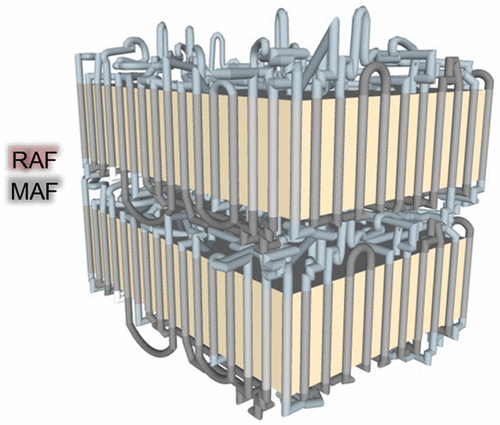The forgotten fraction in semicrystalline semiconducting polymers

A class of materials of utmost fundamental and applied interest is that of semicrystalline polymers. Actually, all solid synthetic polymers are, in general, partly crystalline and partly amorphous. The degree of crystallinity depends on the polymer structure and on how the solid is prepared. Rapid cooling of the molten polymer favors formation of an amorphous solid. Regularity of structure in the polymer molecules favors formation of crystals.
At low temperatures, an amorphous solid polymer is hard and has a glassy appearance. When heated to a certain temperature, the amorphous solid becomes softer, rubberlike, and flexible, the polymer molecules now having enough energy to slide past one another; this temperature is called the glass-transition temperature Tg. Cooling the polymer below Tg locks the chains in fixed, random conformations to produce a hard, disordered, amorphous solid.
A perfectly crystalline polymer would not show a glass transition but would melt at some temperature to a liquid. Perfect polymer crystals do not exist. A semicrystalline polymer shows both a glass-transition temperature Tg and a melting temperature Tm that lies above Tg. Tg is associated with the amorphous portions of the solid and Tm is associated with the crystalline portions. For temperatures between Tg and Tm, one has tiny crystallites embedded in a rubbery matrix.
But there may be a forgotten fraction in this textbook description 1. In fact, these systems exhibit a more complex structure, though, composed of a crystalline fraction, as well as a mobile and rigid amorphous fractions (MAF and RAF, respectively). The latter is generally attributed to regions where chains are constrained at the boundary with the crystalline fraction.
The existence of this boundary region has been indirectly inferred using two methods. One is based on the fact that the specific heat of various semicrystalline polymers between Tg and Tm cannot be described by a two-fraction model; rather the presence of a RAF must be taken into account. A second method relies on the fact that the sum of the crystalline fraction and the MAF, obtained from the melting endotherm and the step in the specific heat at the glass transition, respectively, never equals unity and, consequently, the remaining part of the material must be attributed to the RAF. Both methods provide evidence of the existence of the RAF, though identifying its precise Tg has so far been elusive.
An important subclass of semicrystalline polymers is that of semiconducting conjugated polymers. The presence of delocalized π orbitals makes them attractive systems in applications ranging from solar cells to thin-film electronic circuitry, organic light-emitting diodes, and thermoelectric generators. The optoelectronic properties required for such applications can be profoundly affected by the degree of crystallinity and the thermodynamic state of the amorphous fractions.
Now Jaime Martín (POLYMAT-UPV/EHU), Natalie Stingelin (Georgia Tech), and Daniele Cangialosi (CFM & DIPC) present 2 a systematic study aiming at identifying the glass transition of both the MAF and the RAF. The scientists employ fast scanning calorimetry to provide insights on the glass transition of the archetypal conjugated polymer poly(3-hexylthiophene) (P3HT).
Let’s recall the fundamental definition of the glass transition temperature Tg, that is, the temperature at which the crossover from the equilibrium supercooled melt to the nonequilibrium glass takes place. Given this definition, a system residing in the glassy state will exhibit an evolution of its thermodynamic state toward lower free energies, a phenomenon known as physical aging. By contrast, no timedependent evolution of the thermodynamic state will be observed in the equilibrium supercooled melt.
The researchers employ fast scanning calorimetry to characterize the presence (or not) of physical aging effects, in terms of enthalpy relaxation, using 2-μm thick regioregular P3HT films.
Their results show that, after performing aging experiments over a wide range of temperatures at fixed aging times, the relaxed enthalpy exhibits two main distributions. The low temperature distribution is identified as a manifestation of the glass transition of the MAF. At higher temperatures, enthalpy relaxation originating from aging of the RAF dominates. The extrapolation of the high temperature flanks of the distributions of relaxed enthalpies provides an estimation of the Tg of the MAF and the RAF.
Data clearly indicate that a RAF component is present in P3HT thin films and, thus, likely in other semiconducting polymers. This conclusion highlights the need to consider this often ‘forgotten’ fraction in structural models to understand the optoelectronic properties of these interesting class of materials and, in general, to establish meaningful structure/processing/property interrelationships.
Author: César Tomé López is a science writer and the editor of Mapping Ignorance.
References
- Levine, I.N. (2009) Physical Chemistry 6th Edition, McGraw-Hill, New York (USA) ↩
- Jaime Martín, Natalie Stingelin, and Daniele Cangialosi (2018) Direct Calorimetric Observation of the Rigid Amorphous Fraction in a Semiconducting Polymer J. Phys. Chem. Lett. doi: 10.1021/acs.jpclett.7b03110 ↩